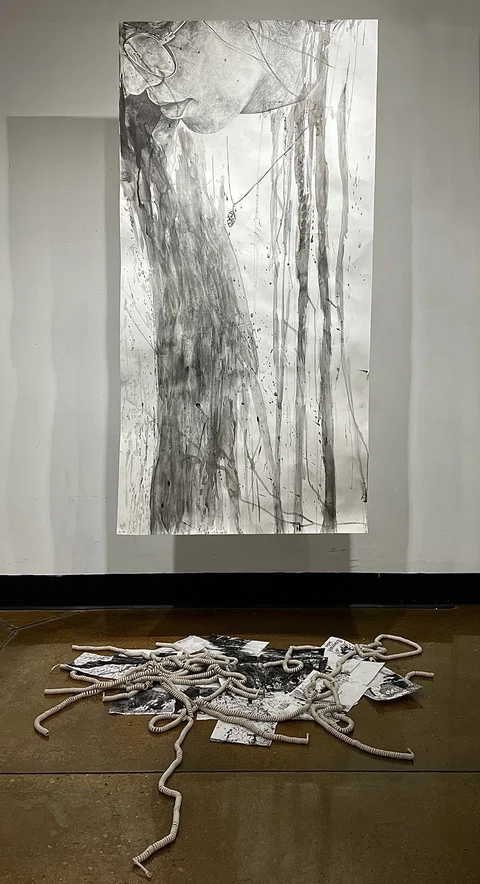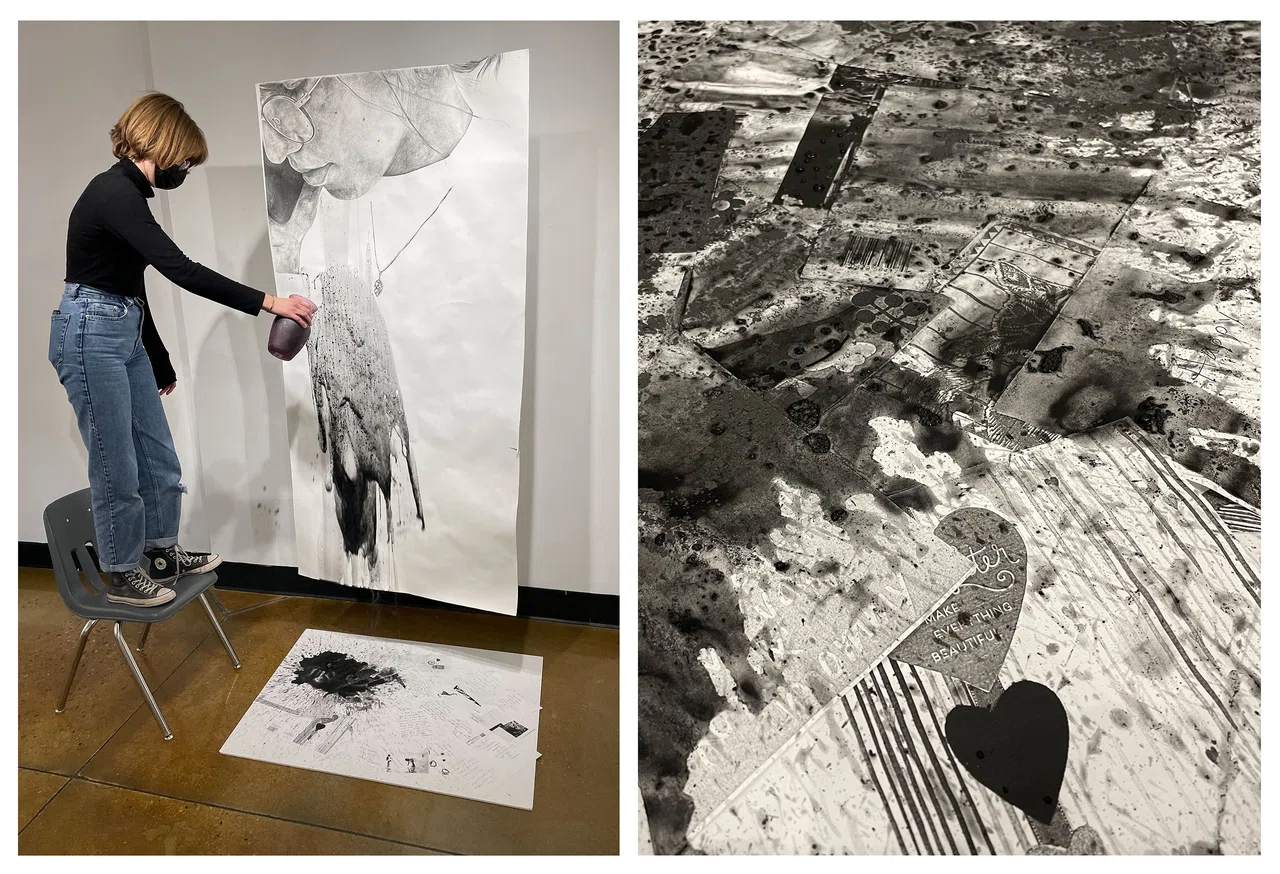







Drawing
Lorelei Gennett
Denver School of the Arts|Denver, Colorado

Hello? I’m Sorry, I Can’t Hear You|72 x 36 in.
Material(s): Graphite and ink on paper destroyed with water, phone cords, photocopies of letters kept from mom
Process(es): Last words with mom on phone, mom=me communication problems, we don’t talk anymore=fear of talking
Curatorial Note: Drawing Installation shows the endless possibilities with drawing.


“How do moments change a person’s life? How are a moment’s repercussions revealed in a person’s present? My inquiry explores how my reality could have changed if my mom had not left when I was nine. I depict pieces of my life my mom impacted, questioning the influence of our relationship on my identity by imagining an alternate life.”
Student statement
Student
statement
A person’s life is defined by the ways in which they experience reality. Reality, then, becomes a culmination of life’s moments. The way we experience each part of our life dictates how we experience our own reality; if one moment changes, how does a person’s life change?
How do finite moments in time affect a person’s past, present, and future?
My sustained investigation explores the way my own reality could have changed if my mother, who left when I was nine, was still a part of my life. I captured an alternate version of my experience determined by her hypothetical presence, rather than absence, in my life and visually questioned how that change could have determined who I have become as a person.
The night my mother left, there was a rainstorm; in my mind, this detail is a distinction between my life before and after her absence. In order to reflect this distinction, each of my pieces is rendered in extreme realism and then destroyed by water, visually demonstrating the falseness of the alternate life I depict and how easily the fantasy can be broken by the reality of my real experience.
This piece, entitled Hello? I’m Sorry, I Can’t Hear You, addresses the effects my mother’s absence has had on my relationships with other people, and my problems with communication. Each piece’s title in my sustained investigation is a quote my mother has said to me at one moment in my life; “Hello? I’m sorry, I can’t hear you,” are the last words I heard in my mom’s voice, and come from a recording of a missed call, which is an audio component of this installation. The self-portrait of me talking on the phone washes away into a pool of broken phone cords, which are entangled in copies of letters and cards that my mom has sent me throughout my life.
Listen to the audio component of the installation
Audio Transcript:
"Hello, sorry I can't hear you."




Lorelei Gennett
Phone calls became the main form of interaction I had with my mom after she left, and I used the motif of phones to symbolize the disconnection that permeated our relationship due to her verbal abuse. The descent of my face into the mess of phone cords and letters demonstrates how much of myself I lost in the attempt to hold on to my mother, and how there are many parts of my life I had to give up in order to let her go.
This sustained investigation, in particular this piece, was difficult to undertake. I technically challenged myself by approaching my investigation with an entirely new medium (watersoluble graphite), destroying my pieces with water, and increasing the scale of many of my pieces to larger-than-life sizes. I was heavily inspired by the photography of Olga Karlovac, whose work features abstracted black-and-white silhouettes that blur the line between positive and negative space. I was also inspired by the literary work of Hanya Yanagihara, especially her book A Little Life, which discusses the idea of a person’s authentic self being revealed in unseen moments.
My teachers were incredibly supportive throughout the process of this piece and the entire portfolio. They constantly encouraged my out-of-left-field ideas and pushed me to experiment with how I approached the process of my work. More than anything, they gave me the space to explore a large part of my identity, to challenge myself with vulnerability, and finally begin the process of healing the grief surrounding my mother.
One piece of advice I would give to any aspiring artist is this: do not be afraid to look at yourself in the mirror. Using art as a way to process and understand your identity and experience is transformative, for it allows you to take ownership of your own story. I began this sustained investigation in a dark place, and I finished it with a deeper understanding of who I am becoming as a person, and an appreciation for my real life, not the fantasy life I had desired for so many years.
So, do not be afraid to create beautiful things from your pain. Do not be afraid to challenge who you believe yourself to be. By beautifully depicting, then beautifully destroying, the echoes of a life that I have grieved for years, I am finally beginning to allow myself to accept my relationship, or lack thereof, with my mother. This inquiry is the goodbye that I never had the words for but that I have always wanted to say to my mother. This inquiry is me, finally, letting go.

Material(s): Graphite and ink on paper destroyed with water, phone cords, photocopies of letters kept from mom
Process(es): Process piece 14. Make piece large=confront end. Mom voicemail=audio installation=last words
Teacher Statement
Teacher Statement
Marty Loftus
As an educator, I attempt to foster a relationship with students as a guide and fellow artist, as well as a teacher. In this work, Lorelei showed tremendous courage in choosing to investigate a highly personal inquiry, and her questions inevitably lead to new directions and creative solutions. Additionally, her ability to take complex ideation and translate this into clear and concise written evidence helped to make her body of work easily accessible.
One of Lorelei’s strengths was her ability to seek, search, and discover throughout the making process, and her willingness to see missteps as opportunities. She continually saw potential in her experiments and was open to the idea that her revisions, while often uncertain, served to reflect the narrative of her inquiry. The synthesis of these processes with her materials and ideas leads to an extraordinary and evocative sustained investigation.
In addition to submitting her AP portfolio to College Board, Lorelei developed a senior thesis show, inviting members of our community to interact with her work and question her processes. This experience furthered her understanding of the work and pushed her into new and exciting directions.
I encourage students and teachers to embrace ideas and explorations with a sense of curiosity before judgment. Our administrative team has been extremely supportive of the knowledge that with inquiry-based art education comes evocative and sometimes controversial work. Many of our students have seen, heard, and experienced great joys, but also great hardships. We commend our leadership team at Denver School of the Arts, and our broader school community, for giving students the ability to explore these life experiences without fear of bias or censorship.
As with many students, I undoubtedly learned as much from Lorelei as she did from me. Her thought process, creative problem-solving, and courage have been inspirational and has undoubtedly made her peers better artists, and me a better teacher for future AP students.
Principal Statement
Principal Statement
Anthony McWright
It is my pleasure to recognize Lorelei Gennett and the AP Art program at Denver School of the Arts under the direction of Mr. Martin Loftus and Mr. Jim Cliff. A part of the philosophy of Denver School of the Arts Art Department strives to build and develop critical thinkers that apply creative and technical application of thought toward authentic artworks.

To give an overview, Denver School of the Arts is unique in that most students stay together in their Art Major for seven years as they grow through Middle to High School. They become close as friends, but more importantly, as a working group of peers who often teach each other. This environment creates strong collaborative skills and encourages experimentation and supporting new ideas along with the opportunity to be strong leaders.
By 10th grade, students are working to produce work based on their own ideas and experiences. Each student begins producing work in a series or a concept they are investigating and creating artwork as a way to research, develop ideas and make art as a consistent body of work to communicate to the viewer.
These practices lead into the 11th grade school year, where students produce a 2-D Design AP Portfolio that is a sustained investigation over the span of the entire year.
12th Grade students produce another portfolio using the skills and practices they have learned and now made part of their process. This year Seniors choose between a Drawing AP Portfolio and a 3-D AP Portfolio.
An exemplar of this creative process is Lorelei Gennett. Lorelei is an outstanding artist and student, and I'm so happy to see her recognized for her process and hard work. The development of this portfolio was a transformation for her as she went from being an art student when entering this program as a 6th grader to an artist who had a drive and passion to make the body of work over this past year.
Lorelei is a thoughtful artist as she consciously makes personal connections in her work. There is often a deeper meaning within her drawings or paintings. Lorelei has used art in recent years to process and understand what is happening in the world around her and become more than a student that can draw and paint. I have watched her grow into an amazing artist over the years, and her AP Art and Design Portfolio is an example of her skill but also her ability to create impactful artwork that is thoughtful and intentional. She continues to gain confidence and learn to push herself to take chances. She is constantly navigating through styles, mediums and working to communicate to the viewer.

Lorelei Gennett














